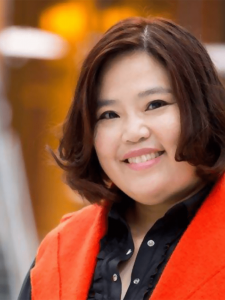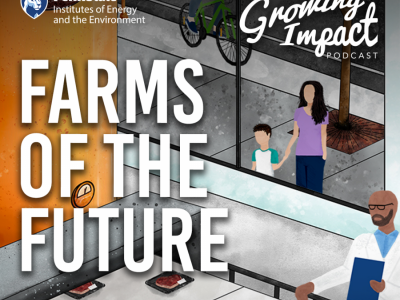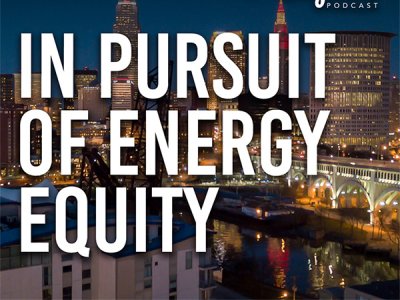Developing renewable energy solutions and innovations is one thing. Having people adopt and implement them is another. To meet that challenge, researchers and designers have been creating art installations to engage the public and grow interest in renewable energy. Using nature as inspiration, the team has developed multiple concepts that look to increase renewable energy literacy and adoption.
Transcript
INTRO: I believe that if renewable energy is the long-term solution for a sustainable future, it should appear as something that we want to be engaged in and learn about it.
HOST: Welcome to Growing Impact, a podcast by the Institutes of Energy and the Environment at Penn State. Growing Impact explores cutting-edge projects of researchers and scientists who are solving some of the world's most challenging energy and environmental issues. Each project has been funded through an innovative seed grant program that's facilitated through IEE. I'm your host, Kevin Sliman.
On this episode of Growing Impact, I speak with Mihyun Kang, the director for sustainability in the College of Arts and Architecture and a researcher in the Stuckeman School. Her research focuses on sustainable interior design and design for special populations. Mihyun’s recent seed grant project, titled Renewable Energy Art and Design, aims to develop a series of renewable energy art and design installations that provide an opportunity for communities to engage with solar-based electricity generation.
HOST: Welcome Mihyun, to Growing Impact.
Mihyun Kang (MK): Thank you so much for having me here. I'll be glad to share my project with you today.
HOST: Can you give me a little background about yourself?
MK: Sure. My name is Mihyun Kang. I'm a research professor in the College of Arts and Architecture. Also, I serve as a director for sustainability in the College of Arts and Architecture. So I'm trying to do my best to foster sustainability in the college.
HOST: Can you tell me about the purpose of your project?
MK: Sure. The purpose of this project was to develop a series with renewable energy art and design to provide an opportunity for the Penn State community and beyond to recognize the benefits of a solar-based electric generation through the form of art and design. I will just say renewable energy art and design is a relatively new type of art and design that generates or harnesses renewable energy for public art in city design. So our research team created various renewable energy art and design work in a meaningful and artistic way and developed prototype mockups to connect the community with the art, design, energy, environment, and culture.

HOST: Perfect, yeah, it's amazing. The connection between energy and the arts is an interesting one. So, could you talk a little bit… how did you get interested in renewable energy? Is that in any of your portfolio, in your background?
MK: Well, we know that climate change is threatening the human health and economic well-being. And it impacts our interaction with the built and natural environments. So socio-ecological decisions for a sustainable future can reduce the negative impact of climate change on human health and economic well-being, especially for vulnerable populations. I believe that if renewable energy is the long-term solution for a sustainable future, it should appear as something that we want to be engaged in and learn about it. So I started exploring how to render this idea with the firm belief that clean energy will make a positive impact on climate change.
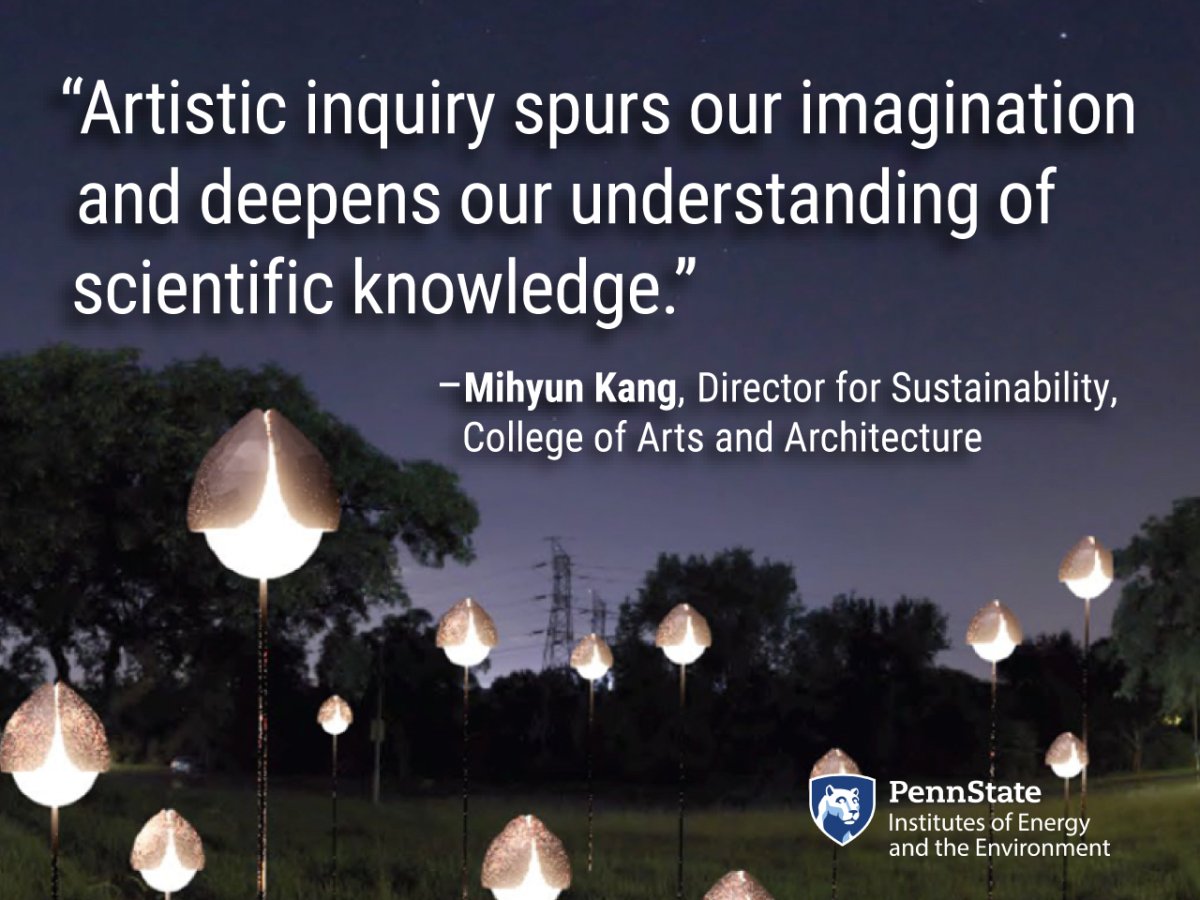
HOST: In your background, did you ever work with renewable energy at all?
MK: Not really. I'm pushing the boundaries of my design area.
HOST: Okay, that’s really cool though. I like that because of that interesting component like, no, I've never done renewable energy, but I want to see how these can be blended for the very purposes that you just pointed out: our world needs some sort of innovations and why not have those innovations be appealing to those who are going to be using those innovations? So that's a beautiful answer, I think.
How can art help communicate about science?
MK: When I talk about art, I mean aesthetic experience that we have in everyday life and we have an innate need for these types of aesthetic experience. Art is to raise awareness and evoke behavior changes through sensory and emotional experiences concerning our ecosystem impact and scientific and technological intervention. The artistic practice of imagination, storytelling, music, dance, drama, visual art, and design contribute to fostering human growth and development with a creative expression of our experience. Artistic inquiry spurs our imagination and deepens our understanding of scientific knowledge. And it will contribute to building a lasting commitment to deeper relationships.
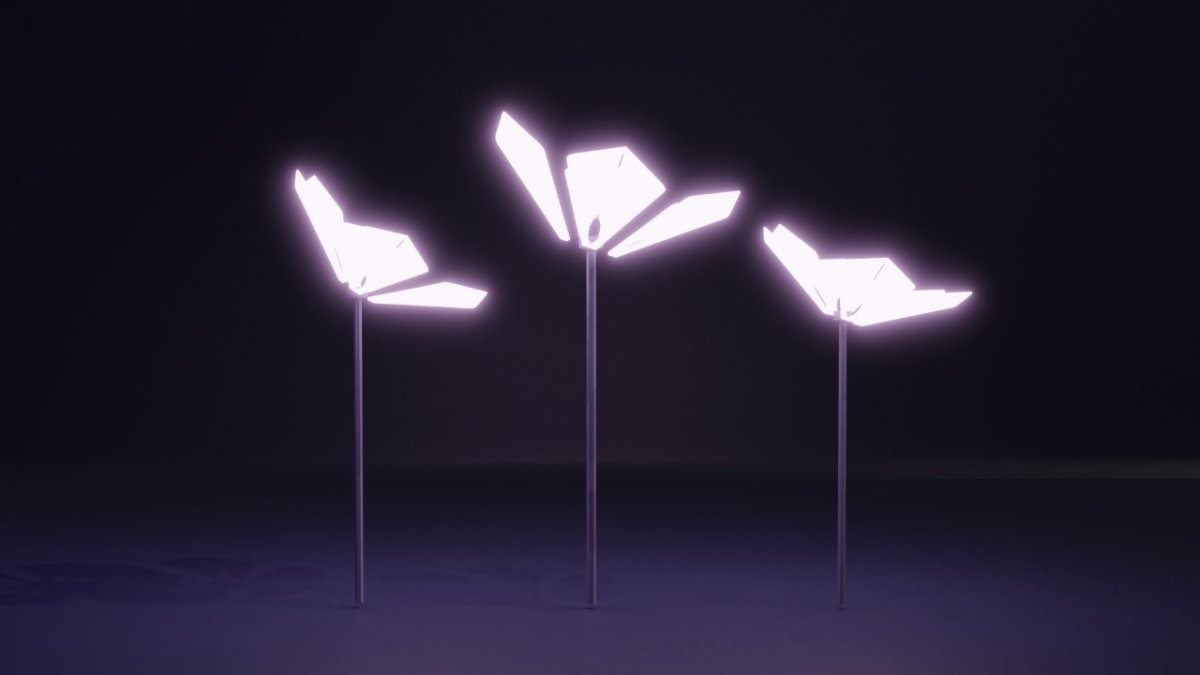
HOST: What benefits do installations like this provide to the community?
MK: This work has not been installed yet. But the exhibition of the proposed design was held last summer. And we shared a visualization of the sustainability and energy system. At the time, interactive educational activities were also organized with the Sustainability Institute in the collaboration. And all of these in the future installations is for the enhancement of energy literacy of the participants and to empower our renewable energy adaptation. So many visitors in the exhibition wondered if the works has been already installed and wanted to visit the place immediately. When they heard, we hope to implement, they asked how they could support moving forward. The installation, as well as the process of renewable energy art and design development, would inspire imagination with a positive attention and impact on the historical environment in local community. Besides either the broader educational and learning opportunities in providing equitable power for public art in city design. So for example, I invited Penn State Student Chapter of the American Solar Energy Society when I develop the prototype mockup. And it was great that we have our student engagement. As such, collaborating with the communities in the development and installation process down the road, can help further discuss sustainability and climate change. And eventually, once installed, the contemporary public art may serve as the place to learn about energy issues where renewable energy is in action.
HOST: I've seen on your mock-ups about places where you hoped to put them on. I think Shaver's Creek was one.
MK: Yes, Shaver's Creek is one place. The Arboretum is one place. So I'm trying to find a place in the local community where visitors can have a meaningful experience.
HOST: Yeah, I suspect State College would be welcoming to that. So I look forward to seeing where you can find a location because I bet, I suggest that the borough itself will be very welcoming and a great place for that to be installed.
Where do you find inspiration to develop the concepts?
MK: My inspiration has the connection with nature. Biophilic design approach by considering the direct and indirect experience of nature and the experience of space and place. We want to connect with nature and have distinctly designed built environments in connection to nature. So particularly for this project, our team desired to integrate ecological identity into renewable energies art and design series that we plan to develop and consider the native flora and fauna for the project. So among the ten renewable energy art and design that we developed, “Luminos” was designed from the official state insect of Pennsylvania, Pennsylvania firefly, which transforms the midsummer night into a fairyland of tiny brilliant twinkling lights, a kind of true wonder of nature. And also beyond it's becoming a significant insect of the region of Pennsylvania, the firefly serves as a symbol of hope and lighting the landscape during dusk. The aesthetic of “Luminos” was closely inspired by the organic and layered aesthetic in the life of the insect. “Luminos” creates a system that can be spread across an open area, showing us with a surprise of firefly light with a solar energy.
Another example of the renewable energy art and design, “Laurel,” was designed to be a system of a structure that observed solar as it were the aesthetic of a flower, the Mountain Laurel, which is the Pennsylvania state flower. The Mountain Laurel is a flower and also acts as an important element for pollination and older configurations in the system of “Laurel” is interchangeable with the movement of a petal. And it's really mimicking the occurrence of the flower itself. So the big inspiration came from nature. Another approach is relating to social issues. For example, renewable energy art and design that we developed, entitled “The Fist,” symbolized the collective spirit, which shows how a movement can inspire change. The large-scale fist is made up with many pieces of solar panels that combine together to form the overall structure. So the concept is we think the principle that creating a larger idea, movement, and social changes can be possible with a small components from all of us.

HOST: Those are really powerful. Are there any components of nature that you find yourself drawn to?
MK: I want to bring the outside to the inside and inside to the outside and really immerse with nature and having the spirit of nature in not only the shape or form, but the way that it works, how it goes, and how it survives. I got many inspirations from nature when we were designing.
HOST: What are the benefits of working on an interdisciplinary team for an art and energy project?
MK: There has been great achievement. The scientific understanding of challenges in climate change, but we still have concerns about energy consumption and pollution. And I think the collaboration opens up maybe the new possibility of environmental performance, expression, and impact on human behavior are shaped and maybe broadening the social and cultural dimension of humanities and art. The interdisciplinary approach, pushing the boundaries of the design and put together artistic sensibilities and ethic inquiry with a scientific pursuit. So maybe it can be the innovative model for sustainable development. Ideally, the form of an emotional engagement with human nature, culture, and science can bring the rationally sound and emotionally compelling solutions.
HOST: Can you talk about future plans and what you hope to see you to happen with this project?
MK: Our research team will continue to seek out additional funds, industry partners, foundations, and the community for the fabrication and installation of their renewable energy art and design pieces that we designed. As I mentioned, we had an exhibition on the proposed design, but have not been fully developed for fabrication and installation. We developed the mock-ups at this point. We might have more community workshops with stakeholders to build a support toward its implementation. And ultimately, we hope to construct many pieces of the renewable energy art and design that we designed for Penn State and Commonwealth campuses to accelerate renewable energy adaptation and enlighten us about clean energy issues.
HOST: Thank you, Mihyun, for being on Growing Impact and discussing your research.
MK: Thanks for the opportunity to talk about my project and thanks for having me here.
HOST: You've been listening to Growing Impact, a podcast by the Institutes of Energy and the Environment at Penn State. I've been your host, Kevin Sliman. To learn more about IEE and to hear previous episodes of Growing Impact, please visit iee.psu.edu. This has been season three episode four. Thank you for listening.

